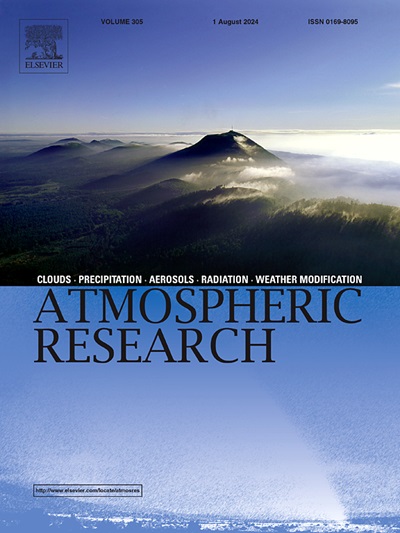2000 年代后长江流域中下游热浪与上游大气波系的强化关系
IF 4.5
2区 地球科学
Q1 METEOROLOGY & ATMOSPHERIC SCIENCES
引用次数: 0
摘要
在全球变暖的背景下,全球热浪的频率和持续时间都在迅速增加。长江中下游流域(MLYRV)也出现了这一趋势,其重大影响引起了公众的高度关注。本研究确定了北大西洋涛动(NAO)正相、乌拉尔阻塞(UB)和长江中下游地区上空的反气旋共同组成的波列,该波列与 1970-2023 年间的长江中下游地区热浪密切相关。我们的研究结果表明,在北大西洋喷流(NAJ)的调节下,MLYRV上空反气旋的发展与乌拉尔阻塞(UB)的能量扩散有关。进一步的分析表明,与 1970-2000 年(P1)相比,2001-2023 年(P2)期间热浪频率与 NAO 指数和 UB 日数的相关性明显增强。这种加强可能是由于在 P2 期间,受大西洋多年涛动(AMO)正相的影响,NAJ 向东北延伸至欧亚大陆北部。预计欧亚大陆高纬度地区的这种强带状风有利于低纬 UB,其强大的下游能量扩散促进了 P2 期间热浪的发展。与此相反,P1 期间欧亚高纬度上空较弱的带风在 AMO 负相的调节下有利于高纬度 UB,由于从高纬度 UB 到 MLYRV 的能量扩散较弱,UB 与热浪之间的相关性不明显。因此,UB 在这个波列中起着重要的桥梁作用,促进了热浪形成所需的能量传递。本文章由计算机程序翻译,如有差异,请以英文原文为准。
The intensifying relationship between heatwaves in the mid–lower reaches of the Yangtze River valley and the upstream atmospheric wave train after the 2000s
The frequency and duration of heatwaves are rapidly increasing worldwide under the background of global warming. This trend is also observed in the mid–lower reaches of the Yangtze River valley (MLYRV), raising great public concern due to its significant impacts. This study identifies a wave train involving the positive phase of the North Atlantic Oscillation (NAO), the Ural blocking (UB), and an anticyclone over the MLYRV, which is closely linked to MLYRV heatwaves during 1970–2023. Our findings indicate that the development of the anticyclone over the MLYRV is associated with the energy dispersion of the UB under the regulation of the North Atlantic jet (NAJ). Further analyses reveal that the correlation of heatwave frequency with the NAO index and UB days is significantly stronger during 2001–2023 (P2) compared to 1970–2000 (P1). This strengthening may be attributable to the northeastward extension of the NAJ to northern Eurasia during P2, modulated by the positive phase of the Atlantic Multidecadal Oscillation (AMO). Such strong zonal winds over high latitudes of Eurasia are expected to favor low-latitude UB, and its robust downstream energy dispersion enhances the development of heatwaves during P2. In contrast, the weaker zonal winds over high latitudes of Eurasia during P1 favor high-latitude UB under the regulation of the negative phase of the AMO, and the correlation between the UB and heatwaves is less significant due to weak energy dispersion from the high-latitude UB to the MLYRV. Consequently, the UB acts as a crucial bridge within this wave train, facilitating the energy transfer necessary for heatwave formation.
求助全文
通过发布文献求助,成功后即可免费获取论文全文。
去求助
来源期刊

Atmospheric Research
地学-气象与大气科学
CiteScore
9.40
自引率
10.90%
发文量
460
审稿时长
47 days
期刊介绍:
The journal publishes scientific papers (research papers, review articles, letters and notes) dealing with the part of the atmosphere where meteorological events occur. Attention is given to all processes extending from the earth surface to the tropopause, but special emphasis continues to be devoted to the physics of clouds, mesoscale meteorology and air pollution, i.e. atmospheric aerosols; microphysical processes; cloud dynamics and thermodynamics; numerical simulation, climatology, climate change and weather modification.
 求助内容:
求助内容: 应助结果提醒方式:
应助结果提醒方式:


